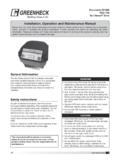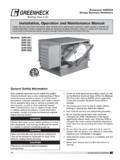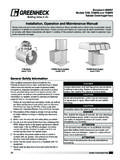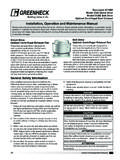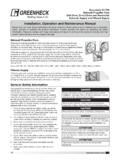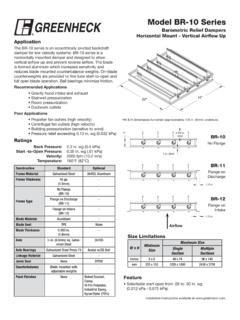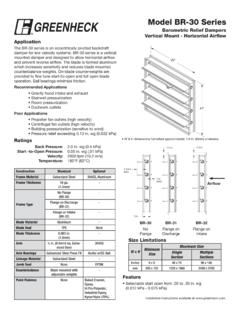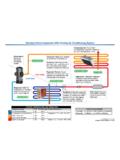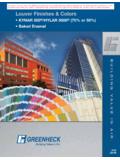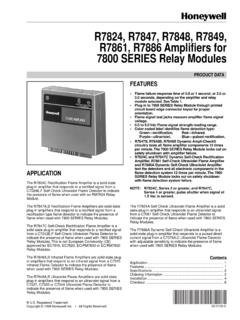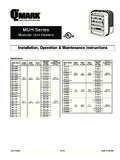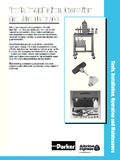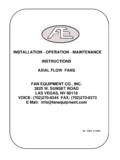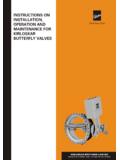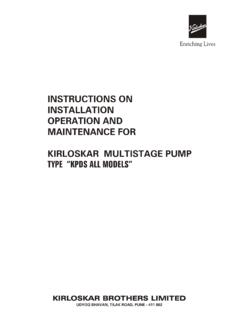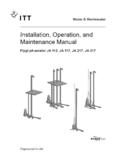Transcription of Installation, Operation and Maintenance Manual
1 Utility and Centrifugal Fans1 installation , Operation and Maintenance ManualPlease read and save these instructions for future reference. Read carefully before attempting to assemble, install, operate or maintain the product described. Protect yourself and others by observing all safety information. Failure to comply with these instructions will result in voiding of the product warranty and may result in personal injury and/or property 479870 Model USFD-100, USF-200, 300 and 400 Model CSWU tility and Centrifugal FansGeneral Safety InformationOnly qualified personnel should install this fan. Personnel should have a clear understanding of these instructions and should be aware of general safety precautions. Improper installation can result in electric shock, possible injury due to coming in contact with moving parts, as well as other potential hazards.
2 Other considerations may be required if seismic activity is present. If more information is needed, contact a licensed professional engineer before moving Follow all local electrical and safety codes, as well as the National Electrical Code (NEC) and the National Fire Protection Agency (NFPA), where applicable. Follow the Canadian Electric Code (CEC) in The rotation of the wheel is critical. It must be free to rotate without striking or rubbing any stationary Motor must be securely and adequately Do not spin fan wheel faster than max cataloged fan RPM. Adjustments to fan speed significantly effects motor load. If the fan RPM is changed, the motor current should be checked to make sure it is not exceeding the motor nameplate Do not allow the power cable to kink or come in contact with oil, grease, hot surfaces or chemicals. Replace cord immediately if Verify that the power source is compatible with the Never open access doors to a duct while the fan is disconnect, lock and tag power source before installing or servicing.
3 Failure to disconnect power source can result in fire, shock or serious servicing the fan, motor may be hot enough to cause pain or injury. Allow motor to cool before should be taken in explosive carter les risques d incendie, de choc lectrique ou de blessure grave, veiller toujours d brancher, verrouiller et tiqueter la source de courant avant l installation ou l de toute intervention sur la soufflante, le moteur peut tre suffisamment chaud pour provoquer une douleur voire une blessure. Laisser le moteur refroidir avant toute preuve de pr caution dans les atmosph res and Centrifugal Fans2 ReceivingUpon receiving the product, check to ensure all items are accounted for by referencing the delivery receipt or packing list. Inspect each crate or carton for shipping damage before accepting delivery. Alert the carrier of any damage detected.
4 The customer will make a notation of damage (or shortage of items) on the delivery receipt and all copies of the bill of lading which is countersigned by the delivering carrier. If damaged, immediately contact your local representative. Any physical damage to the unit after acceptance is not the responsibility of that all required parts and the correct quantity of each item have been received. If any items are missing, report shortages to your local representative to arrange for obtaining missing parts. Sometimes it is not possible that all items for the unit be shipped together due to availability of transportation and truck space. Confirmation of shipment(s) must be limited to only items on the bill of are to be rigged and moved by the lifting brackets provided or by the skid when a forklift is used. Location of brackets varies by model and size.
5 Handle in such a manner as to keep from scratching or chipping the coating. Damaged finish may reduce the ability of the fan to resist corrosion. Fans should never be lifted by the shaft, fan housing, motor, belt guard, windband or Rotate fan wheel monthly and purge bearings once every three months Energize fan motor once every three months Store belts flat to keep them from warping and stretching Store unit in a location which does not have vibration After storage period, purge grease before putting fan into storage of fan is in a humid, dusty or corrosive atmosphere, rotate the fan and purge the bearings once a month. Improper storage which results in damage to the fan will void the are protected against damage during shipment. If the unit cannot be installed and operated immediately, precautions need to be taken to prevent deterioration of the unit during storage.
6 The user assumes responsibility of the fan and accessories while in storage. The manufacturer will not be responsible for damage during storage. These suggestions are provided solely as a convenience to the - The ideal environment for the storage of fans and accessories is indoors, above grade, in a low humidity atmosphere which is sealed to prevent the entry of blowing dust, rain or snow. Temperatures should be evenly maintained between 30 to 110 F (-1 to 43 C), wide temperature swings may cause condensation and sweating of metal parts. All accessories must be stored indoors in a clean, dry any accumulations of dirt, water, ice, or snow and wipe dry before moving to indoor storage. To avoid sweating of metal parts allow cold parts to reach room temperature. To dry parts and packages use a portable electric heater to remove any moisture build up.
7 Leave coverings loose to permit air circulation and to allow for periodic unit should be stored at least 3 inches (89 mm) off the floor on wooden blocks covered with moisture proof paper or polyethylene sheathing. Aisles between parts and along all walls should be provided to permit air circulation and space for - Fans designed for outdoor applications may be stored outdoors, if absolutely necessary. Roads or aisles for portable cranes and hauling equipment are fan should be placed on a level surface to prevent water from leaking into the fan. The fan should be elevated on an adequate number of wooden blocks so it is above water and snow levels and has enough blocking to prevent it from settling into soft ground. Locate parts far enough apart to permit air circulation, sunlight and space for periodic inspection. To minimize water accumulation, place all fan parts on blocking supports so rain water will run not cover parts with plastic film or tarps as these cause condensation of moisture from the air passing through heating and cooling cycles.
8 Fan wheels should be blocked to prevent spinning caused by strong and Maintenance During StorageWhile in storage, inspect fans once per month. Keep a record of inspection and Maintenance moisture or dirt accumulations are found on parts, the source should be located and eliminated. At each inspection, rotate the wheel by hand ten to fifteen revolutions to distribute lubricant in motor and bearings. If paint deterioration begins, consideration should be given to touch-up or repainting. Fans with special coatings may require special techniques for touch-up or and Centrifugal Fans3 Machined parts coated with rust preventive should be restored to good condition promptly if signs of rust occur. Immediately remove the original rust preventive coating with petroleum solvent and clean with lint-free cloths. Polish any remaining rust from surface with crocus cloth or fine emery paper and oil.
9 Do not destroy the continuity of the surfaces. Thoroughly wipe clean with Tectyl 506 (Ashland Inc.) or the equivalent. For hard to reach internal surfaces or for occasional use, consider using Tectyl 511M Rust Preventive, WD-40 or the from StorageAs fans are removed from storage to be installed in their final location, they should be protected and maintained in a similar fashion until the fan equipment goes into to assembly and installation of the unit and system components, inspect the fan assembly to make sure it is in working Check all fasteners, set screws on the fan, wheel, bearings, drive, motor base and accessories for Rotate the fan wheel by hand and assure no parts are rubbing. Access to the wheel is obtained through a bolted panel located on the side of the fan Ensure proper wheel settings for radial gap and alignment. Refer to Radial Gap, Overlap and Wheel Alignment section on page of ContentsGeneral Safety Information.
10 1 Receiving .. 2 Unpacking .. 2 Handling .. 2 Storage .. 2 Inspection and Maintenance During Storage ..2-3 Removing from Storage .. 3 General Information Unit and System Identification Tags .. 4 Pre- installation Information .. 4 Electrical Disconnects .. 4 Moving Parts .. 4 Guards - Motor Cover, Weatherhood, Shaft, Belt, Inlet or Outlet Guard .. 4 Access Doors .. 4 Air Pressure and Suction .. 4 Fans - Rigging and Lifting ..5-9 installation Discharge Positions .. 10 Ducted Inlet Installations .. 10 Ducted Outlet Installations .. 11 Non-Ducted Installations .. 11 Fan Drainage Piping and Trap Detail .. 11 Bases (Foundation and Isolation) .. 12 Electrical Disconnects and Moving Parts .. 12UL/cUL 762 Listed Fans for Restaurant Exhaust .. 12 Electrical Connections.
